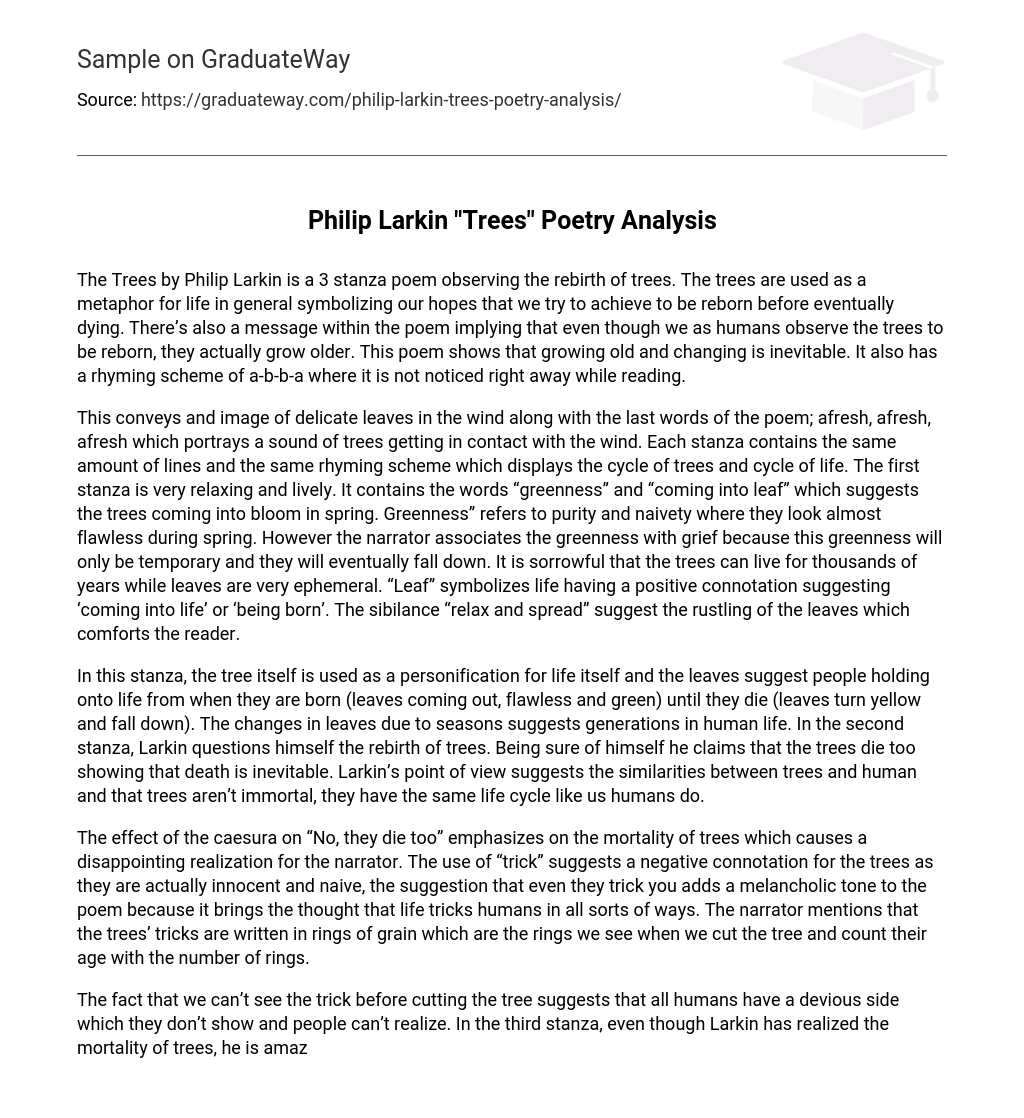The Trees by Philip Larkin is a 3 stanza poem observing the rebirth of trees. The trees are used as a metaphor for life in general symbolizing our hopes that we try to achieve to be reborn before eventually dying. There’s also a message within the poem implying that even though we as humans observe the trees to be reborn, they actually grow older. This poem shows that growing old and changing is inevitable. It also has a rhyming scheme of a-b-b-a where it is not noticed right away while reading.
This conveys and image of delicate leaves in the wind along with the last words of the poem; afresh, afresh, afresh which portrays a sound of trees getting in contact with the wind. Each stanza contains the same amount of lines and the same rhyming scheme which displays the cycle of trees and cycle of life. The first stanza is very relaxing and lively. It contains the words “greenness” and “coming into leaf” which suggests the trees coming into bloom in spring. Greenness” refers to purity and naivety where they look almost flawless during spring. However the narrator associates the greenness with grief because this greenness will only be temporary and they will eventually fall down. It is sorrowful that the trees can live for thousands of years while leaves are very ephemeral. “Leaf” symbolizes life having a positive connotation suggesting ‘coming into life’ or ‘being born’. The sibilance “relax and spread” suggest the rustling of the leaves which comforts the reader.
In this stanza, the tree itself is used as a personification for life itself and the leaves suggest people holding onto life from when they are born (leaves coming out, flawless and green) until they die (leaves turn yellow and fall down). The changes in leaves due to seasons suggests generations in human life. In the second stanza, Larkin questions himself the rebirth of trees. Being sure of himself he claims that the trees die too showing that death is inevitable. Larkin’s point of view suggests the similarities between trees and human and that trees aren’t immortal, they have the same life cycle like us humans do.
The effect of the caesura on “No, they die too” emphasizes on the mortality of trees which causes a disappointing realization for the narrator. The use of “trick” suggests a negative connotation for the trees as they are actually innocent and naive, the suggestion that even they trick you adds a melancholic tone to the poem because it brings the thought that life tricks humans in all sorts of ways. The narrator mentions that the trees’ tricks are written in rings of grain which are the rings we see when we cut the tree and count their age with the number of rings.
The fact that we can’t see the trick before cutting the tree suggests that all humans have a devious side which they don’t show and people can’t realize. In the third stanza, even though Larkin has realized the mortality of trees, he is amazed by the desire and the enthusiasm of the trees renewing every season for years and years in every condition of weather and disasters. The first line seems very positive with “Yet still” portraying hope after the previous disappointment. Unresting castles thresh” resembles a heroic figure and masculinity suggesting a noise that the trees and leaves make while fighting with the strong wind and never ending the cycle no matter what happens. Larkin continues to praise the trees saying “full-grown thickness” emphasizing the strength of the leaves against the strong wind of May. This shows that they are very strong even though they seem very delicate and fragile. The tone becomes pessimistic once again by Larkin reminding death again. So, this stanza contains all the emotions carried on throughout the poem; melancholy, hope, pessimism”.
Larkin’s use of “They seem to say” confuses the reader as who “they” are unknown. However, “they” suggests the trees being personified and the rusting of the leaves continue with this sibilance. This personification allows the reader to think of trees as being one of us and as they have a say as well. Larkin wanted the ending of repetition of afresh to end with the leaves still rusting in the wind just like throughout the poem which creates a peaceful and a lively atmosphere. It also signifies life and the awareness of them being alive. Afresh also suggests renewal and hope.
In conclusion, Larkin portrays life using trees as an example. This can be due to the trees giving us life by giving off oxygen. There is a melancholic side of this poem where even though the trees are reborn every year, Larkin sees them as dying as well, which shows hopelessness and meaningless of life . He recognizes the trees growing old whereas humans wouldn’t realise this through the trick of trees renewal. When the poem is read first, it gives a calm and peaceful feeling just like how the rusting of leaves do. As the reader goes deeply in it, the melancholy of the poem is unfurled.





